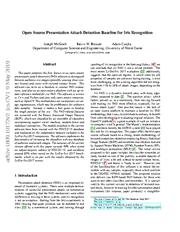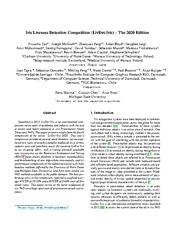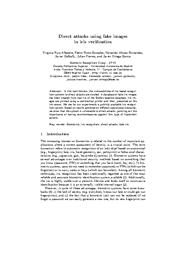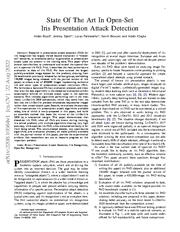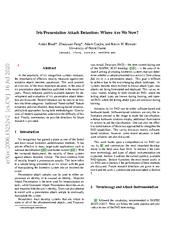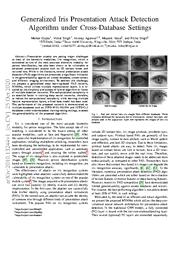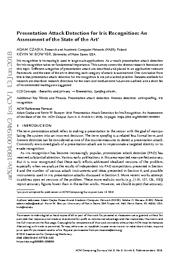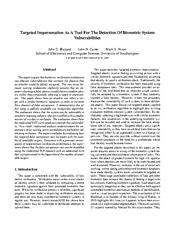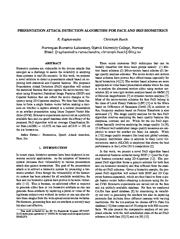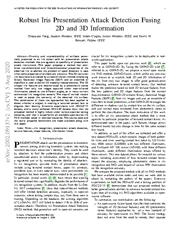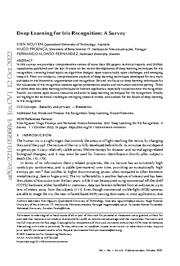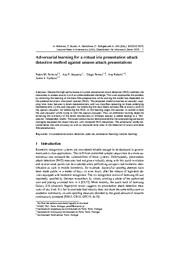A copy of this work was available on the public web and has been preserved in the Wayback Machine. The capture dates from 2019; you can also visit the original URL.
The file type is application/pdf.
Filters
Open Source Presentation Attack Detection Baseline for Iris Recognition
[article]
2019
arXiv
pre-print
This paper proposes the first, known to us, open source presentation attack detection (PAD) solution to distinguish between authentic iris images (possibly wearing clear contact lenses) and irises with ...
This software can serve as a baseline in various PAD evaluations, and also as an open-source platform with an up-to-date reference method for iris PAD. ...
To our knowledge, this is the first and only proposal of an open source solution for iris presentation attack detection. ...
arXiv:1809.10172v2
fatcat:lqwgqb6zjbcnbaq7giq4dergdq
Open Source Iris Recognition Hardware and Software with Presentation Attack Detection
[article]
2020
arXiv
pre-print
This paper proposes the first known to us open source hardware and software iris recognition system with presentation attack detection (PAD), which can be easily assembled for about 75 USD using Raspberry ...
The primary goal of this work is to offer a low-cost baseline for spoof-resistant iris recognition, which may (a) stimulate research in iris PAD and allow for easy prototyping of secure iris recognition ...
Open Source Iris Presentation Attack Detection (PAD) Software. ...
arXiv:2008.08220v1
fatcat:dpqji5k6ofhnpn5j6dhcbs6tu4
Iris Liveness Detection Competition (LivDet-Iris) – The 2020 Edition
[article]
2020
arXiv
pre-print
Launched in 2013, LivDet-Iris is an international competition series open to academia and industry with the aim to assess and report advances in iris Presentation Attack Detection (PAD). ...
This paper serves as the latest evaluation of iris PAD on a large spectrum of presentation attack instruments. ...
Open Source Algorithms For completeness, three open-source iris PAD algorithms available today in the public domain (in addition to the baseline algorithms) are also evaluated. ...
arXiv:2009.00749v1
fatcat:hbzafdvy5bfc3evhbt2ti6oqny
Iris Liveness Detection Competition (LivDet-Iris) - The 2020 Edition
2020
2020 IEEE International Joint Conference on Biometrics (IJCB)
Launched in 2013, LivDet-Iris is an international competition series open to academia and industry with the aim to assess and report advances in iris Presentation Attack Detection (PAD). ...
, and (c) performance comparison of the submitted entries with three baseline methods (offered by the University of Notre Dame and Michigan State University), and three open-source iris PAD methods available ...
Open Source Algorithms For completeness, three open-source iris PAD algorithms available today in the public domain (in addition to the baseline algorithms) are also evaluated. ...
doi:10.1109/ijcb48548.2020.9304941
fatcat:4li536skmba4vnlsqeongr5usa
Direct Attacks Using Fake Images in Iris Verification
[chapter]
2008
Lecture Notes in Computer Science
A database of fake iris images has been created from real iris of the BioSec baseline database. Iris images are printed using a commercial printer and then, presented at the iris sensor. ...
We use for our experiments a publicly available iris recognition system, which some modifications to improve the iris segmentation step. ...
Fig. 6 . 6 Examples of fake images with correct iris detection (left) and incorrect iris detection (right).
Table 1. Options tested for fake iris generation. ...
doi:10.1007/978-3-540-89991-4_19
fatcat:r6jtiqpg2ndy3abbanxey6tnlm
State Of The Art In Open-Set Iris Presentation Attack Detection
[article]
2022
arXiv
pre-print
Research in presentation attack detection (PAD) for iris recognition has largely moved beyond evaluation in "closed-set" scenarios, to emphasize ability to generalize to presentation attack types not present ...
Second, we evaluate the accuracy of five open-source iris presentation attack algorithms available today, one of which is newly-proposed in this paper, and build an ensemble method that beats the winner ...
Open Source Iris PAD Baseline The Open Source Iris Presentation Attack Detection [32] baseline utilizes multiple BSIF-based (Binary Statistical Image Features) filters as its feature extractor and a ...
arXiv:2208.10564v1
fatcat:r3bv4376arhphdjlqp3jyqylfu
Iris Presentation Attack Detection: Where Are We Now?
[article]
2020
arXiv
pre-print
Newly-released, publicly-available datasets for development and evaluation of iris presentation attack detection are discussed. ...
This work presents an overview of the most important advances in the area of iris presentation attack detection published in recent two years. ...
[25] developed an open source PAD method based on 2D iris texture features for detecting textured contact lenses, available in both C++ and Python. ...
arXiv:2006.13252v2
fatcat:dr5uis65x5apvb52xly6cp7mqa
Generalized Iris Presentation Attack Detection Algorithm under Cross-Database Settings
[article]
2020
arXiv
pre-print
Iris recognition, which is considered as one of the most accurate biometric modality for person identification, has also been shown to be vulnerable to advanced presentation attacks such as 3D contact ...
While in the literature, several presentation attack detection (PAD) algorithms are presented; a significant limitation is the generalizability against an unseen database, unseen sensor, and different ...
[36] have developed an open-source iris presentation attack detection module utilizing publicly available machine learning feature extraction and classification algorithms. Fang et al. ...
arXiv:2010.13244v1
fatcat:bb2ixkqxwrgzll6crdrcs6oc24
Presentation Attack Detection for Iris Recognition: An Assessment of the State of the Art
[article]
2018
arXiv
pre-print
Iris recognition is increasingly used in large-scale applications. As a result, presentation attack detection for iris recognition takes on fundamental importance. ...
One conclusion from this is that presentation attack detection for iris recognition is not yet a solved problem. ...
presentation attack detection competitions open to the public. ...
arXiv:1804.00194v3
fatcat:5zufurfqx5c4xcmupulc7ziycu
Targeted impersonation as a tool for the detection of biometric system vulnerabilities
2013
2013 IEEE Sixth International Conference on Biometrics: Theory, Applications and Systems (BTAS)
It demonstrates this effect using a publicly available iris recognition algorithm. ...
The evaluation shows that the system can be vulnerable to attackers targeting subjects who are enrolled with a smaller section of iris due to occlusion. ...
The iris baseline measurements are presented in figure 1. ...
doi:10.1109/btas.2013.6712744
dblp:conf/btas/BustardCN13
fatcat:bl4iciacqnh2jmtqd53oktkw6y
Presentation Attack Detection Algorithm For Face And Iris Biometrics
2014
Zenodo
This justifies the applicability of the proposed 2D Cepstum for accurate presentation attack detection. ...
Baseline face and Iris system In order to evaluate the performance of 2D face recognition system, we employ the well-established face recognition baseline system based on the Sparse Representation Classifier ...
doi:10.5281/zenodo.43982
fatcat:zbzijdc6ardupoys2z4i3tni6u
Robust Iris Presentation Attack Detection Fusing 2D and 3D Information
[article]
2020
arXiv
pre-print
Diversity and unpredictability of artifacts potentially presented to an iris sensor calls for presentation attack detection methods that are agnostic to specificity of presentation attack instruments. ...
available open-source iris PAD methods tested in identical scenarios. ...
Also, the authors would like to thank Diego Gragnaniello, Yang Hu and Joseph McGrath for making their iris PAD source codes available for evaluation. ...
arXiv:2002.09137v2
fatcat:mpd5dxyluzgndcjmqp5pt2wzc4
Deep Learning for Iris Recognition: A Survey
[article]
2022
arXiv
pre-print
Fourth, we review open-source resources and tools in deep learning techniques for iris recognition. ...
Second, we focus on deep learning techniques for the robustness of iris recognition systems against presentation attacks and via human-machine pairing. ...
ACKNOWLEDGMENTS We would like to thank Adam Czajka from the University of Notre Dame, USA for the contribution in the early version of this survey paper in Sections 1, 5 and 6. ...
arXiv:2210.05866v1
fatcat:7xhng57jhrdibi6vuvb2pqxdni
Adversarial learning for a robust iris presentation attack detection method against unseen attack presentations
2019
Biometrics and Electronic Signatures
Despite the high performance of current presentation attack detection (PAD) methods, the robustness to unseen attacks is still an under addressed challenge. ...
The adversarial model obtained better loss and accuracy as well as improved error rates in the detection of attack and bona fide presentations. ...
Acknowledgements This work was financed by the ERDF European Regional Development Fund through the Operational Programme for Competitiveness and Internationalization -COMPETE 2020 Programme and by National ...
dblp:conf/biosig/FerreiraSPRC19
fatcat:ykiqegdjrjg5vnekdqmz3ebrfq
Score Fusion Strategies in Single-Iris Dual-Probe Recognition Systems
2018
Proceedings of the 2018 2nd International Conference on Biometric Engineering and Applications - ICBEA '18
In this paper, through a benchmark on the CASIA-IrisV4-Interval dataset and on the iris corpus of the BioSecure dataset, the aforementioned method is shown to be viable for an iris recognition system. ...
It has been shown, that in a single-instance dual-probe setup, fusing the probe scores yields significant biometric performance increase over the single-probe baseline. ...
fundamental presentation attack detection (PAD) [12] . ...
doi:10.1145/3230820.3230823
dblp:conf/icbea/DrozdowskiWRB18
fatcat:lc3lohtycjcvrd72kwjq72jhii
« Previous
Showing results 1 — 15 out of 1,858 results

